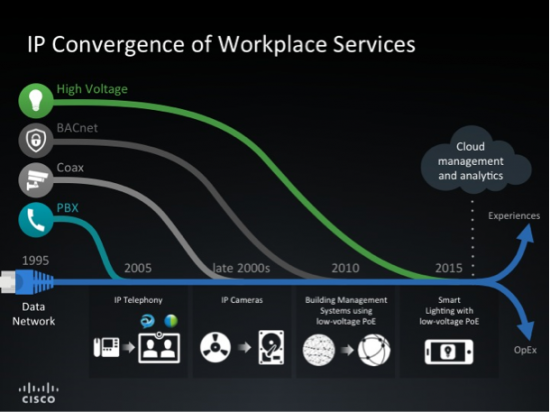Today, the Internet of Everything (IoE) is driving massive transformation in smart lighting. In the next few decades, lighting and other building services will be converged over Internet Protocol (IP) and we call this the Digital Ceiling.
This transformation began with PBX telephone lines migrating to Voice over IP (VoIP) in the mid-2000s. Today, nearly two-thirds of all enterprises will use VoIP. Now that voice is on the data network, we enjoy unified communications combining voice, video, and collaboration to bridge the distance among distributed teams. This is an early example of IoE driving enhanced consumer experiences and lower operational costs. Transformation of this type has been repeated over the years, with security cameras and building controls as well.
The Digital Ceiling is Cisco’s industry-leading approach to light up dark assets through a digital overlay in the enterprise. The Digital Ceiling enables buildings to adapt to people’s dynamic needs in real-time. It is a unified building services approach that provides central control for systems and adds an intelligent sensor platform to inform smarter decision making.
Convergence of building and tenant services through IP not only lowers the cost of installation, operation, and management, but enables transformative new experiences through unified communications and centralized control of global facilities. All systems are monitored and managed from a single dashboard, versus the disparate set of systems and controls typical of most buildings currently.
Some examples of unified building services include:
- Lighting levels that take into account the ambient light streaming through a window;
- Heating and cooling systems that account for actual occupancy in an area of the building;
- Signage and way-finding that automatically connects to and informs visitors’ personal devices;
- Continuous monitoring of building access points for both security and traffic data;
- Occupancy and area usage that’s tracked to inform better space utilization and configuration.
It’s not just about centralization or control, although these are significant benefits. The real game changer is the data and analytics available through the cloud. The value of this solution is increased exponentially through a much improved employee and customer experience, in addition to the benefits of cost reduction and environmentally responsible energy management.
Lighting as an Intelligent Sensor Platform
The advent and continuous improvement of LED light bulbs has opened the door to bring lighting into the Digital Ceiling. The power efficiency of LED bulbs allows them to draw power from the Ethernet cable instead of high-voltage AC conduits. Lights on Power over Ethernet (PoE) – coupled with cloud analysis of sensor data and centralized system management – makes this fertile ground for disruption by Cisco that extends beyond the network. Because of its pervasive coverage, lighting is the ideal physical infrastructure upon which to attach a network of sensors to send data about people and the environment to the cloud.
Through the advances of cloud analytics, we are now able to make historically “dumb” devices such as light bulbs, cameras, and other sensing devices, into data sources. The relayed data includes environmental information that can be analyzed and acted upon in real-time. This has significant implications for real estate, construction, and municipalities seeking to capitalize upon or economize their infrastructure.
You can certainly imagine the possibilities for smart lighting in a workplace setting. Not only does it provide for optimized levels of lighting based on actual occupancy and building usage, but it‘s part of a unified building services solution. These unified services include temperature control through the existing heating, ventilation, and air conditioning (HVAC), smoke and fire detection, video cameras, building access control, and Wi-Fi. All of this runs through single cable connectivity that includes power that requires substantially less installation time and that lowers total cost of system ownership by 20 to 30 percent.
On February 25, I will be presenting on The Expanding World of Smart Lighting at the Strategies in Light conference in Las Vegas. If you’re interested in more information about smart lighting and the solutions in development by Cisco, you should make it a point to attend.
